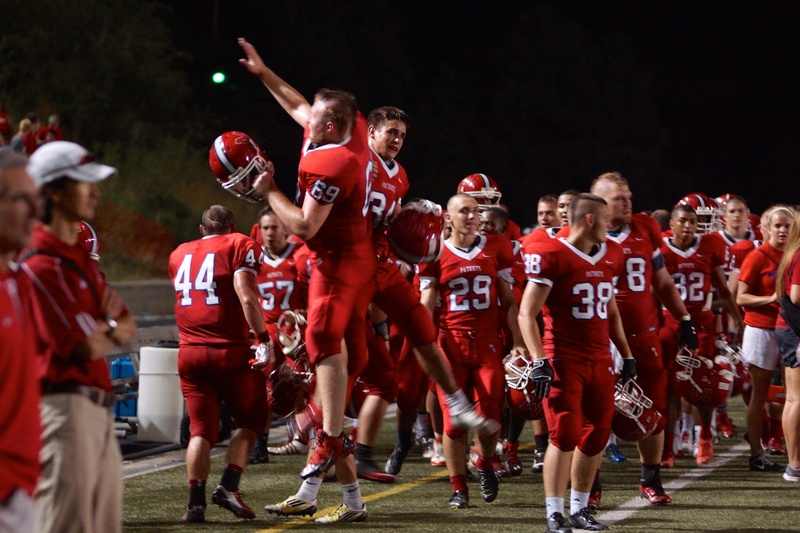Division I Football Evaluation Period Has Arrived: How Prepared Are You?
Are You Serious About Playing College Ball?
By Will Cummings
myHitNews.com
A very important day in the annual recruiting cycle began on April 15, 2009. Beginning on this date and running thru May 31st, 2009, the NCAA allows its member schools to visit high schools to evaluate senior-to-be football prospects. In this case that means members of the class of 2010.

Each NCAA Division I school will submit to the NCAA a consecutive four week schedule of when it will conduct its evaluations of high school prospects. Some D-1 schools started on the 15th of April, but most will start their evaluation periods in May. Hey, after spring football a lot of college coaches are in need of a little break.
Passing the Eyeball Test
During their visits, the college coaches are not allowed to talk to the athletes, but they can watch an athlete workout, or practice or they can attend a sporting event like a track meet or baseball game. Perhaps the most important thing they will do there–besides visit with a prospect’s coach–is review official academic records—they will want to know if the prospect will be academically eligible to enter their college. Moreover, for most of the college coaches it will be the first time they get to see a prospect. They’re there to see if you are really the size you claim to be and do you physically look to be the type of player they want.
Will You Pass the Eyeball Test?
Prospects should be aware to be on their best behavior and to dress appropriately (in other words–look big) during this period. In addition, the athlete, coach and parent/guardian should make sure to have a highlight film and best game film available to give to any college coaches that may show up during this period. I included the athlete and parent/guardian in this process because–technically–it is not the head coach’s responsibility to make sure an athlete has a highlight film or game film available.
The truth of the matter is that some high school coaches are better than others in making sure an athlete’s films are: 1. Prepared. 2. Readily available and 3.Distributed on a timely basis. In fact, I can tell you about an actual incident that happened not too long ago where a high school head football coach told a father of a talented high school junior,“Don’t worry about sending out game film or highlights right now, because colleges don’t start asking for that stuff until a player’s senior year.” Yea! It really happened.
It’s hard to believe that many coaches still believe they can wait until a player’s senior year to prepare and send out their film when all the facts paint a different picture.
The following facts should leave no doubt in your mind that you need to be out there as early as possible in order to compete for scholarships:
1. D-1 schools are allowed to start offering football scholarships the first week in September of a prospect’s junior season.
2. Many D-1 schools have in the neighborhood of 30-50 offers out to juniors by January of the junior year recruiting cycle.
3. Right now, some of the top-tier D-1 schools have nearly half of their scholarship slots filled with early commits.
This is how fast the game is moving these days!!! In other words–colleges are already reviewing sophomore film to evaluate prospects.
It’s never too early to send film–but it can often be too late!
How Serious Are You About Playing College Football?
In today’s recruiting environment, if a player is truly serious about playing D-1 football they should have their highlights film and their best game film(s) available no later than right after the conclusion of their junior football season.
Ideally, a prospect will have already made a sophomore highlight film.
But guess what? Right now–today– there are a lot of very talented juniors out there that have no highlight film or game film ready. Some of these no-film-juniors, along with their parent/guardian, get upset because they see highlight videos of other junior prospects being profiled on Rivals and other recruiting services sites like myHitNews.com. They then turnaround and complain—often to me– that he (or their son) is being overlooked.
No! that’s not always the case. Some players are not being reported on because the athlete and/or paent/guadian and/or coach did not take advantage of all the opportunities available Or even worse, the player and or parent simply thought that somehow the head coach would take care of it all. A critical mistake!” That’s a mistake that I here about way to often.”
I repeat: there are coaches that do a good job of doing a lot of what is needed to be done during the recruiting process—but there are plenty of others who do not. Unfortunately, there are also a few that quite frankly do a very poor job of helping Johnny get to the next level.
Helping Johnny get to the next level is nowhere to be found in a high school head football coach’s job desription–and some coaches will come right out and tell you that!
If an athlete is serious about receiving a football scholarship–at any level–he better figure out real quick that his film has got to get out there to colleges, recruiting services and media outlets as soon as possible. Because the players that get the D-1AA or D-II scholarships, nowadays, are the players who–first–got good looks from D-1A schools.
Don’t You Get It?
Back in Mid-March Rivals and other recruiting services already picked and gave grades and or stars to the nation’s top 100-200 football prospects in the class of 2010—they looked at film to do it! Get your film out to as many colleges and media outlets as you can. You never know who might stumble upon your video, season stats, or reported size/measurable and become interested in finding out more about you. It happens more than you think.
Attend Camps
Are you serious about playing D-1 ball? Then make sure you attend at least a couple of camps and go on visits to college campuses. A much overlooked part of the recruiting process is the rapport that is built between the athlete and a college staff. Often the final decision between one player getting offered versus another comes down to the staff’s “ gut feeling” about a prospect. The only way for a college coach to assess that is through physically being in the presence of a prospect and having multiple conversation with him in person and/or over the phone.
You can start attending camps as early as your freshman year in high school. Camps desinged specifically for the prepsent class of 2010 prospects started way back in January. For Example: As a result of an outstanding performance at the Army Camp, held in January, Creighton Prep’s Nick Mizaur was selected to play in the Max Emfinger National High School All-American Bowl Classic.
Training
If you are a regular to this site you have seen me mention the following names: Niles Paul, Harlan Gunn, Philip Bates, Tim Biere, Shaun Prater, Sean Prater, Collins Okafor. All of these players Play D-1 ball—almost all played as true freshman. They also all trained at Redzone Leadership Academy. What is the secret to Redzone?
It’s all about speed and movement and emphasis on position specific drills.

Just about everyone will tell you that the difference between high school ball and college is the speed of the game. In high school, a lot of emphasis is put into weight training, because your bigger and stronger high school teams tend to have the most success. At the college level, you still have to be big and strong but the difference maker in terms of success is movement and speed. At the college level, he who moves quicker or runs faster usually wins the individual battle. Why? Because strength-wise most players at the college level are the same—it’s the quickness and/or speed that usually separates their abilities.
Go to a Redzonetraining session and you will quickly find out whether you are a 335 lb lineman or 160 lb back, you better be movin’ and you better be movin’ quickly. Any camp that you find that will emphasis football specific drills, quick movement and speed is will worth the investment.
All the players I mentioned above also share something else in common: They were all very good high school players, yet they sought ways to get better—to be the best. And they dedicated the extra time and effort to achieve their goals.
So are you serious about being a college football player? Well, a good start would be to look at what other successful players have already done to get to where you want to be.
Then get your films ready, your camps in line and find a place to train during the offseason that will give you that extra edge you will will need to be successful at the next level. But none of it will be possible if you don’t have the grades. So keep hittin’ those books.


